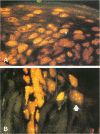Abstract
Fluorescence in situ hybridization has become a major tool for analysis of gene and chromosome copy number in normal and malignant tissue. The technique has been applied widely to fresh tissue and dispersed formalin-fixed, paraffin-embedded archival tissue, but its use on sections of archival tissue has largely been limited to sections < 6 mu thick. This does not provide intact, uncut nuclei for accurate analysis of gene or chromosome copy number. We report here a method of hybridization to sections > 20 microns thick that overcomes these difficulties. Key developments were the use of DNA probes directly labeled with fluorochromes and optical sectioning using laser-scanning confocal microscopy.
Full text
PDF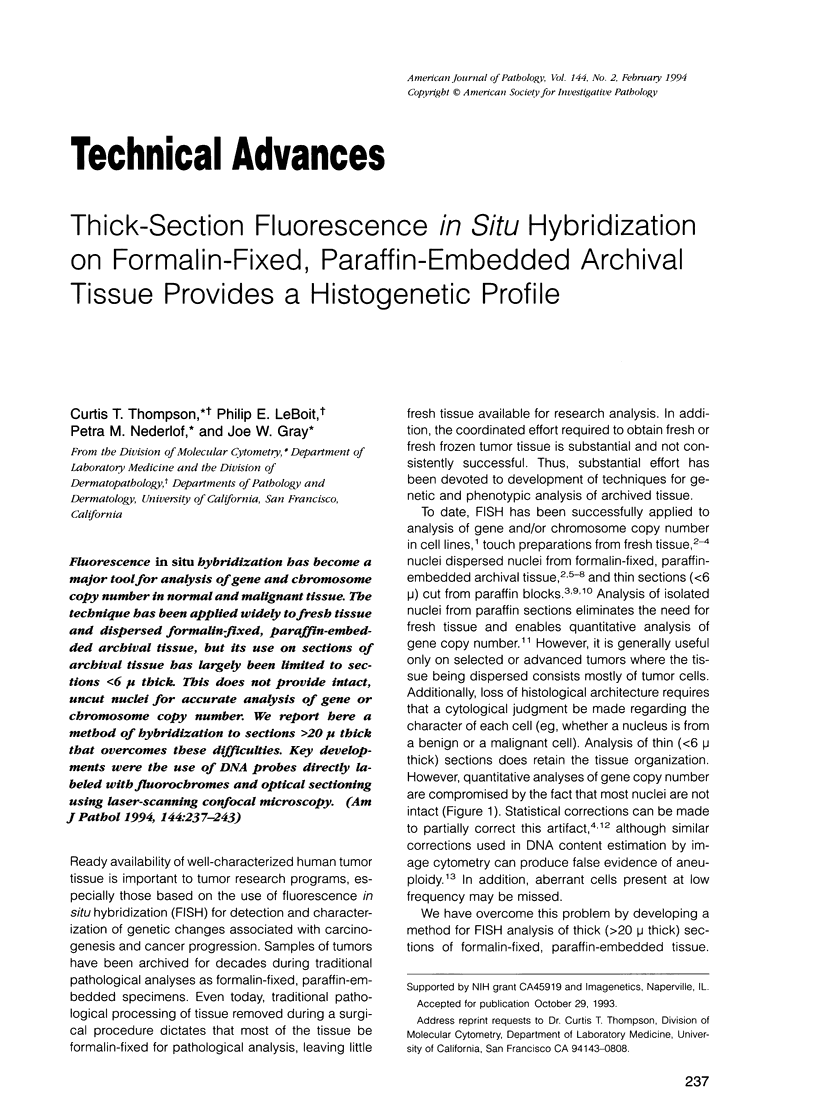
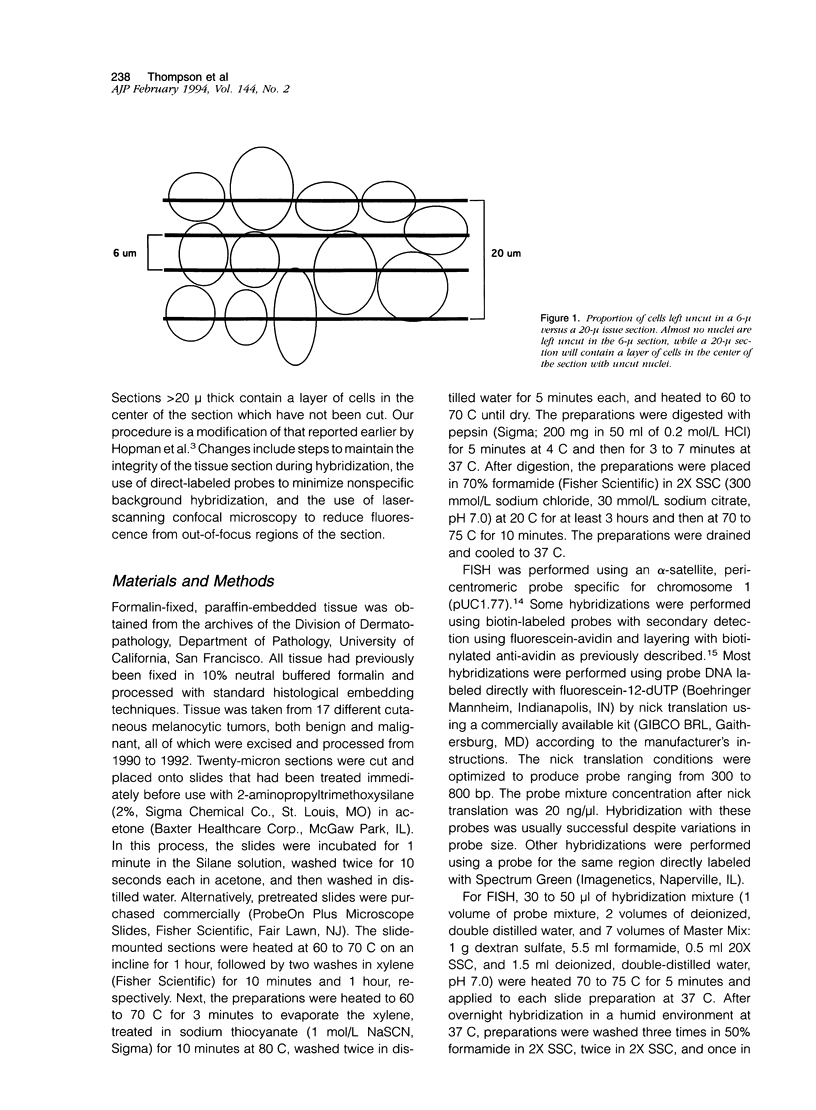
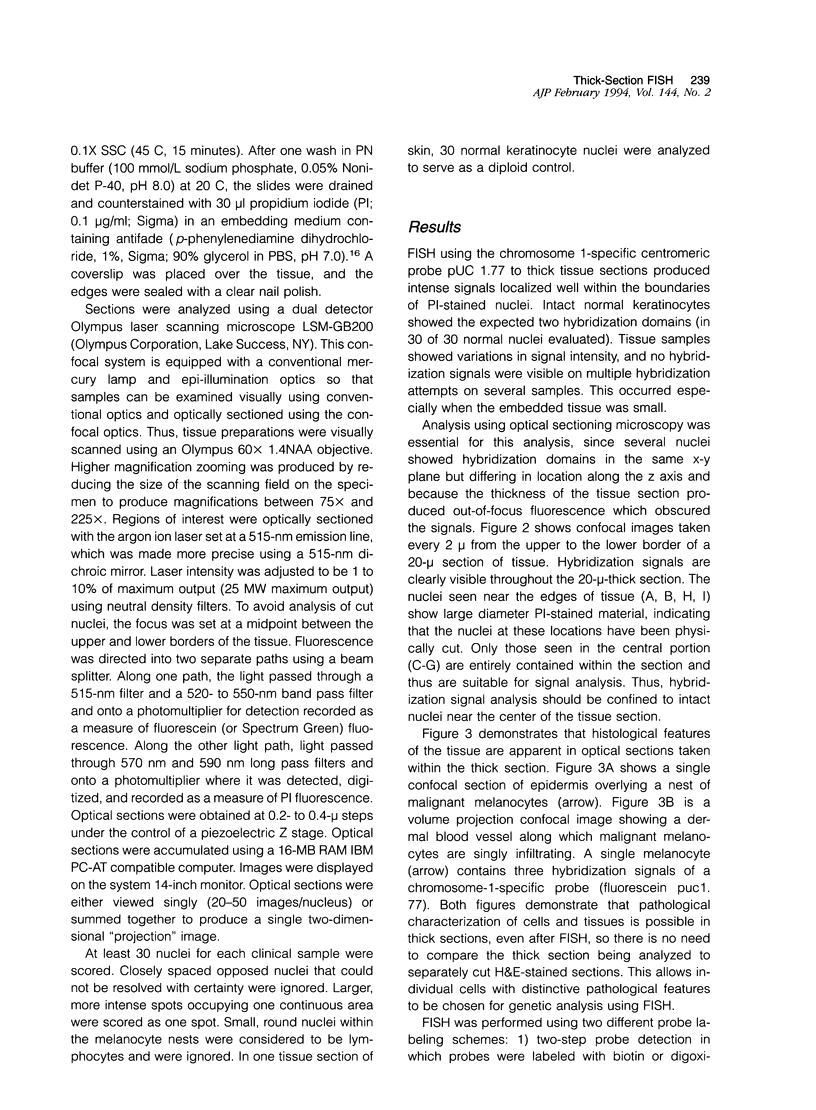
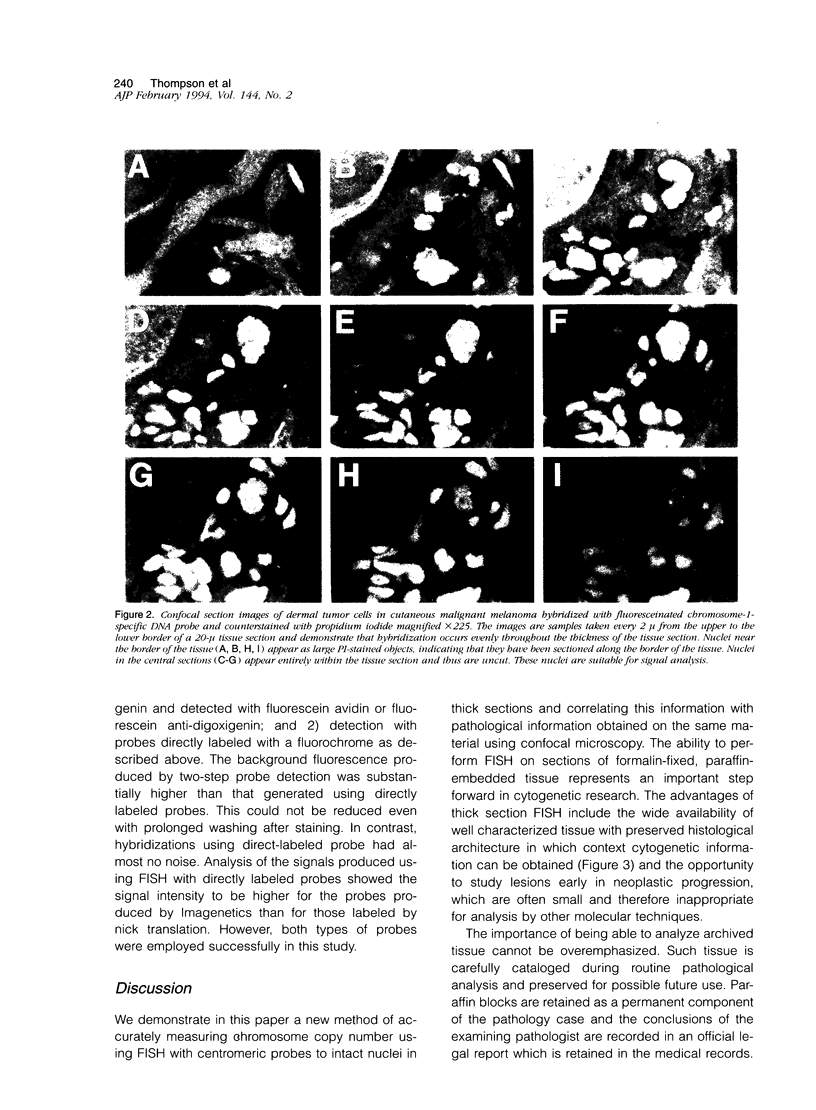
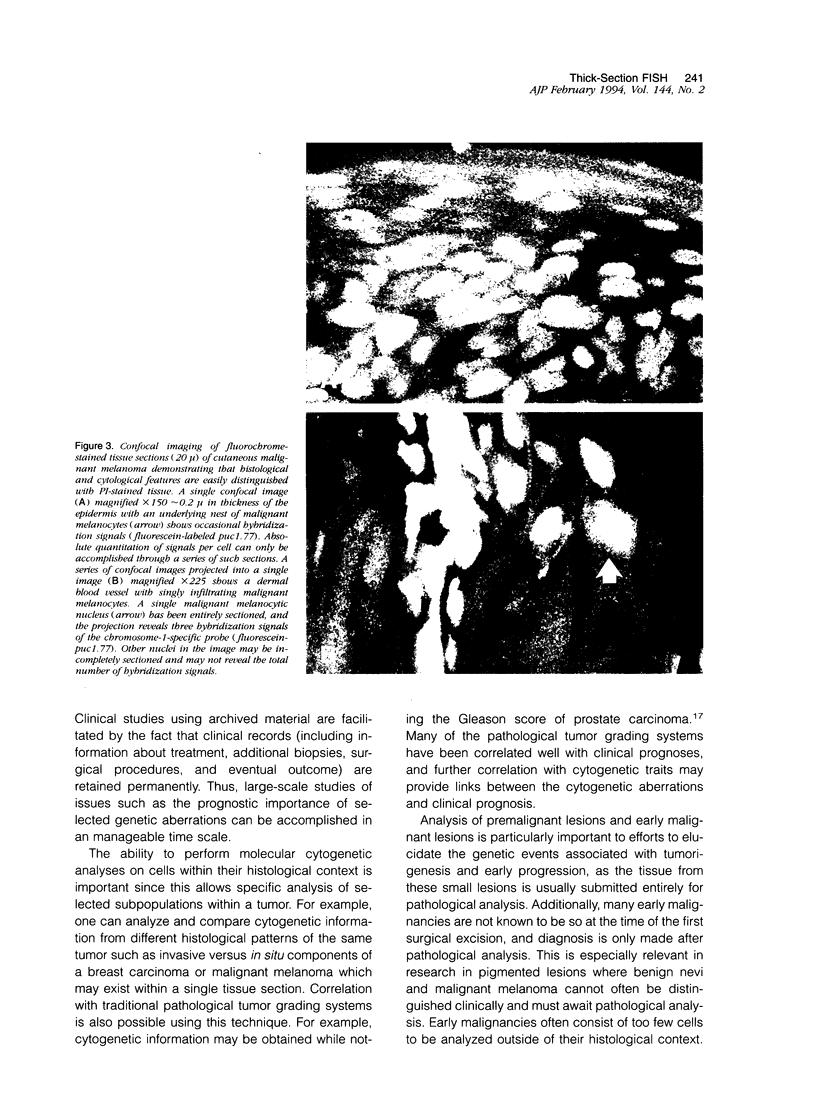
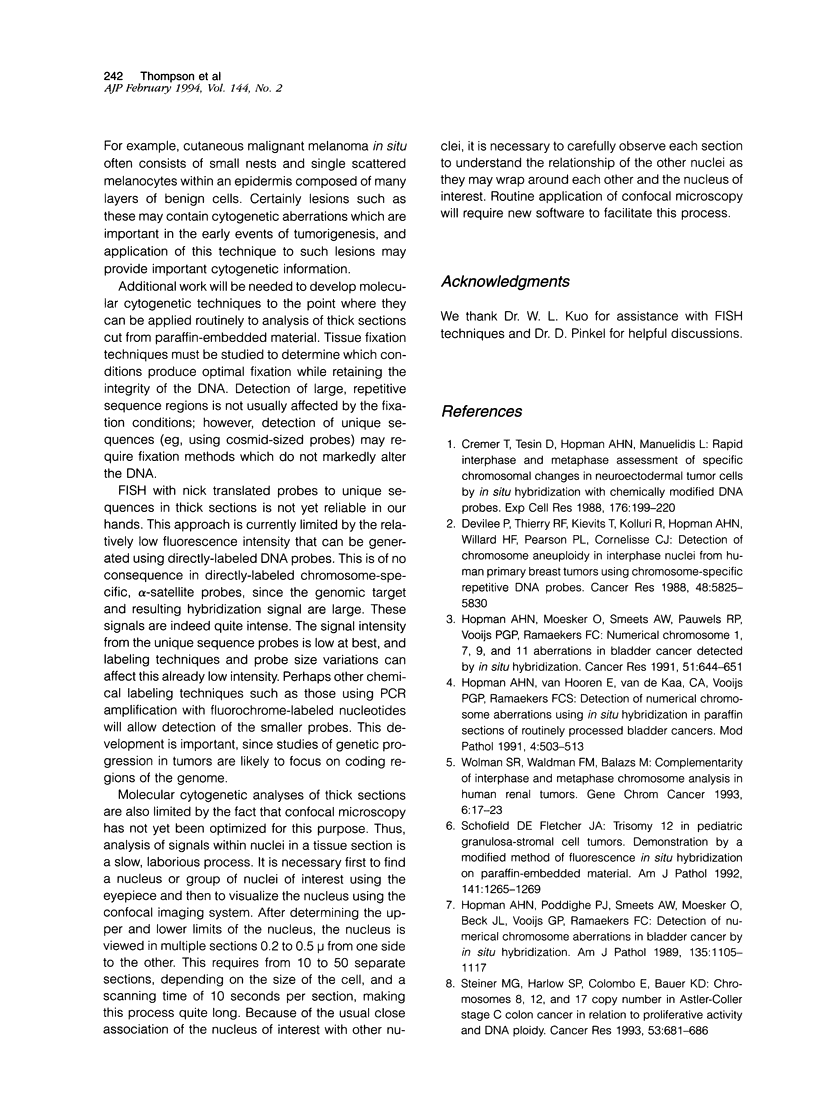
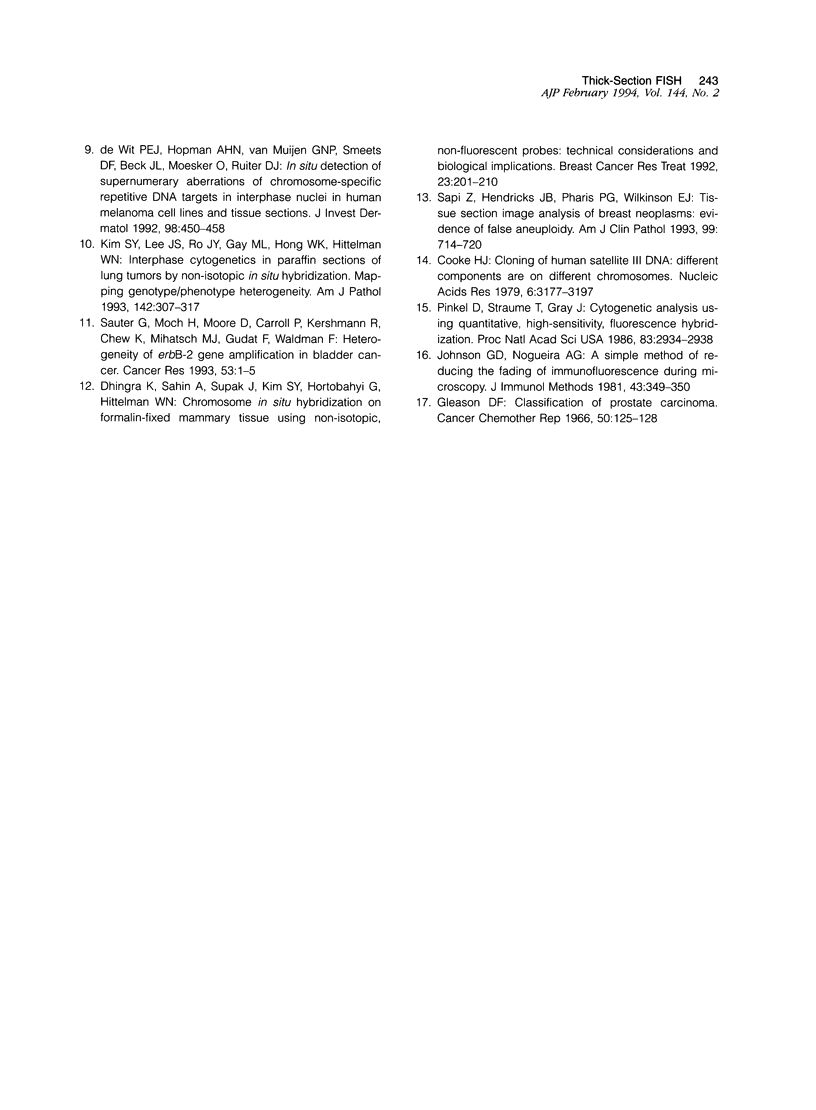
Images in this article
Selected References
These references are in PubMed. This may not be the complete list of references from this article.
- Cooke H. J., Hindley J. Cloning of human satellite III DNA: different components are on different chromosomes. Nucleic Acids Res. 1979 Jul 25;6(10):3177–3197. doi: 10.1093/nar/6.10.3177. [DOI] [PMC free article] [PubMed] [Google Scholar]
- Cremer T., Tesin D., Hopman A. H., Manuelidis L. Rapid interphase and metaphase assessment of specific chromosomal changes in neuroectodermal tumor cells by in situ hybridization with chemically modified DNA probes. Exp Cell Res. 1988 Jun;176(2):199–220. doi: 10.1016/0014-4827(88)90325-4. [DOI] [PubMed] [Google Scholar]
- Devilee P., Thierry R. F., Kievits T., Kolluri R., Hopman A. H., Willard H. F., Pearson P. L., Cornelisse C. J. Detection of chromosome aneuploidy in interphase nuclei from human primary breast tumors using chromosome-specific repetitive DNA probes. Cancer Res. 1988 Oct 15;48(20):5825–5830. [PubMed] [Google Scholar]
- Dhingra K., Sahin A., Supak J., Kim S. Y., Hortobagyi G., Hittelman W. N. Chromosome in situ hybridization on formalin-fixed mammary tissue using non-isotopic, non-fluorescent probes: technical considerations and biological implications. Breast Cancer Res Treat. 1992;23(3):201–210. doi: 10.1007/BF01833516. [DOI] [PubMed] [Google Scholar]
- Gleason D. F. Classification of prostatic carcinomas. Cancer Chemother Rep. 1966 Mar;50(3):125–128. [PubMed] [Google Scholar]
- Hopman A. H., Moesker O., Smeets A. W., Pauwels R. P., Vooijs G. P., Ramaekers F. C. Numerical chromosome 1, 7, 9, and 11 aberrations in bladder cancer detected by in situ hybridization. Cancer Res. 1991 Jan 15;51(2):644–651. [PubMed] [Google Scholar]
- Hopman A. H., Poddighe P. J., Smeets A. W., Moesker O., Beck J. L., Vooijs G. P., Ramaekers F. C. Detection of numerical chromosome aberrations in bladder cancer by in situ hybridization. Am J Pathol. 1989 Dec;135(6):1105–1117. [PMC free article] [PubMed] [Google Scholar]
- Hopman A. H., van Hooren E., van de Kaa C. A., Vooijs P. G., Ramaekers F. C. Detection of numerical chromosome aberrations using in situ hybridization in paraffin sections of routinely processed bladder cancers. Mod Pathol. 1991 Jul;4(4):503–513. [PubMed] [Google Scholar]
- Horio Y., Takahashi T., Kuroishi T., Hibi K., Suyama M., Niimi T., Shimokata K., Yamakawa K., Nakamura Y., Ueda R. Prognostic significance of p53 mutations and 3p deletions in primary resected non-small cell lung cancer. Cancer Res. 1993 Jan 1;53(1):1–4. [PubMed] [Google Scholar]
- Johnson G. D., Nogueira Araujo G. M. A simple method of reducing the fading of immunofluorescence during microscopy. J Immunol Methods. 1981;43(3):349–350. doi: 10.1016/0022-1759(81)90183-6. [DOI] [PubMed] [Google Scholar]
- Kim S. Y., Lee J. S., Ro J. Y., Gay M. L., Hong W. K., Hittelman W. N. Interphase cytogenetics in paraffin sections of lung tumors by non-isotopic in situ hybridization. Mapping genotype/phenotype heterogeneity. Am J Pathol. 1993 Jan;142(1):307–317. [PMC free article] [PubMed] [Google Scholar]
- Pinkel D., Straume T., Gray J. W. Cytogenetic analysis using quantitative, high-sensitivity, fluorescence hybridization. Proc Natl Acad Sci U S A. 1986 May;83(9):2934–2938. doi: 10.1073/pnas.83.9.2934. [DOI] [PMC free article] [PubMed] [Google Scholar]
- Sapi Z., Hendricks J. B., Pharis P. G., Wilkinson E. J. Tissue section image analysis of breast neoplasms. Evidence of false aneuploidy. Am J Clin Pathol. 1993 Jun;99(6):714–720. doi: 10.1093/ajcp/99.6.714. [DOI] [PubMed] [Google Scholar]
- Schofield D. E., Fletcher J. A. Trisomy 12 in pediatric granulosa-stromal cell tumors. Demonstration by a modified method of fluorescence in situ hybridization on paraffin-embedded material. Am J Pathol. 1992 Dec;141(6):1265–1269. [PMC free article] [PubMed] [Google Scholar]
- Steiner M. G., Harlow S. P., Colombo E., Bauer K. D. Chromosomes 8, 12, and 17 copy number in Astler-Coller stage C colon cancer in relation to proliferative activity and DNA ploidy. Cancer Res. 1993 Feb 1;53(3):681–686. [PubMed] [Google Scholar]
- Wolman S. R., Waldman F. M., Balazs M. Complementarity of interphase and metaphase chromosome analysis in human renal tumors. Genes Chromosomes Cancer. 1993 Jan;6(1):17–23. doi: 10.1002/gcc.2870060105. [DOI] [PubMed] [Google Scholar]
- de Wit P. E., Hopman A. H., van Muijen G. N., Smeets D. F., Beck J. L., Moesker O., Ruiter D. J. In situ detection of supernumerary aberrations of chromosome-specific repetitive DNA targets in interphase nuclei in human melanoma cell lines and tissue sections. J Invest Dermatol. 1992 Apr;98(4):450–458. doi: 10.1111/1523-1747.ep12499853. [DOI] [PubMed] [Google Scholar]




